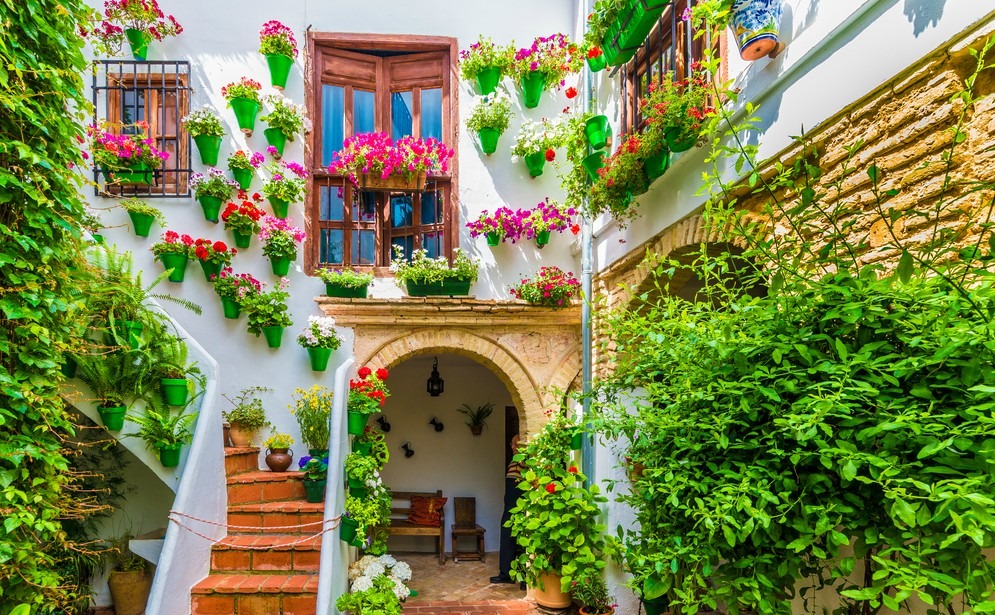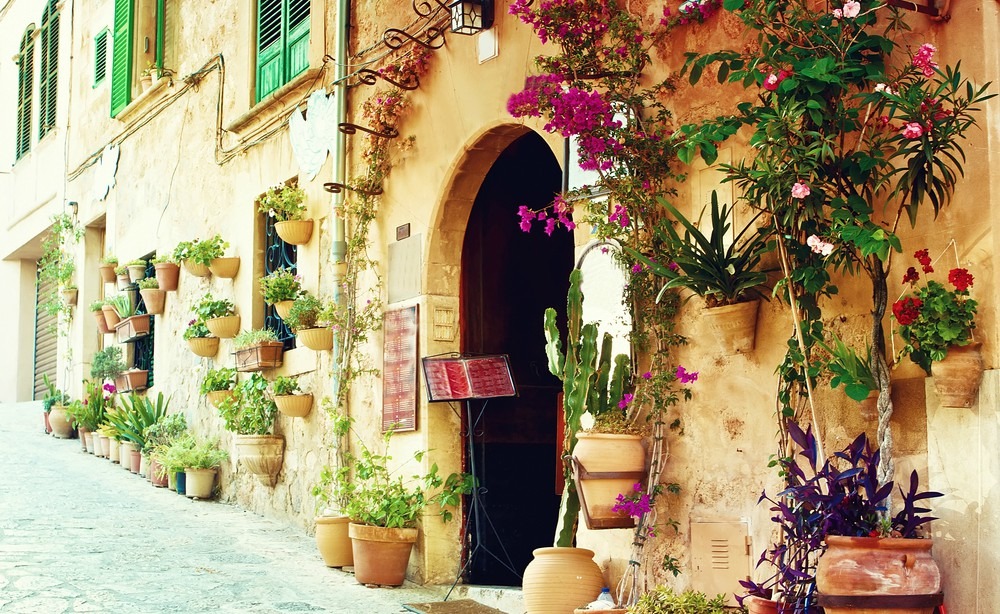Whether you have bought a villa with garden or patio, an apartment with terrace or a finca with land, they all give you the chance to create a lovely outside space for everyone to enjoy.
Spain is a country for outdoor living most of the year. It has thousands of kilometres of lovely beaches, cities and towns with parks and green areas, but most people want their own piece of space in which to while away the hours peacefully, perhaps with a beer or glass of cava in hand.
Most people want their own piece of space in which to while away the hours.
Find homes in Spain via our property portal.
The UK garden
The British Isles are ideal for lush foliage and plants and flowers which thrive in cool and sometimes difficult situations. Clay soil allows for the glorious azaleas, rhododendrons and hydrangeas. The temperate climate attracts plants which are happy in cooler conditions, but also sun loving flowers like geraniums in the summer months. The English country garden is synonymous with foxgloves, canterbury bells and delphiniums. How many glorious paintings there are depicting the cottage garden!
The Spanish garden
The climate and soil in Spain does not bode well for many of our glorious British flowers and plants. Often, the earth will be very dry for several months and temperatures too high to sustain many of them – including my favourite, sweet peas. However, you can create a lovely Mediterranean garden, which doesn’t need plenty of water or cool weather. In the mountainous regions there is more scope for an “English style” garden but you will still need to consider the altitude and chill factor.
Water
Water, or the lack of it, is one of the most important aspects of gardening in Spain. In the south and most coastal regions, rainfall is infrequent but often torrential. Areas towards the north fare better in terms of precipitation, but also tend to have dry summers and water usage can be pricey if you irrigate with garden hoses. Should your property have a deep well, you can tap the water with an electric pump and provide irrigation for a small cost. However, if you are reliant on mains water, keeping your garden green can be very expensive.
Some people install underground water tanks which trap rain, but they might not collect enough water to last a whole summer. Nevertheless, they can be useful in areas with average levels of rainfall and over time can save money.

Don’t let a lack of water or outdoor space hold you back from gardening in Spain.
You will see numerous wonderfully green golf courses throughout Spain and they take a lot of the available water. Sometimes affecting neighbouring districts, causing them to have water shortages occasionally due to the amount used for the course. If you are buying a property close to a golf course, it is a good idea to check the water supply before you buy.
Generally though, it is best to create a garden with plants that need little or no water and which can survive drought and high temperatures.
Suitable plants
The best way to discover which plants do well in your area is to head straight for the local garden centre. Here you will see an array of flowers and shrubs which the locals buy and therefore which are suitable for you to plant. If in doubt, ask one of the garden centre’s employees about suggestions – there is usually someone who will speak some English. There are many websites available that provide all sorts of tips for gardening in Spain, including the gardening section of spain-info.co.uk.
Wherever you wish to live in Spain, knowing how to negotiate for your property should get you a little more garden or patio for your money! Download our guide: How to Negotiate Abroad.
Creating a Mediterranean style garden needs some knowledge and imagination but there are many magnificent Spanish gardens from which to get inspiration. Visit your local botanical gardens to see what can be done with plants and flowers grown locally.
In the spring many Spanish towns have flower festivals, often offering visits to private gardens, generally hidden from public view. These are another source of good ideas for the gardener and can often provide surprises.
Potted plants
People with terraces or small patios often prefer to put their plants in pots to maximise the space available.
Head to the garden centre to buy terracotta or plastic pots in various sizes. Terracotta pots are definitely preferable for plants, as the soil can breathe better than in plastic pots but they are more expensive, especially if you need a large size. The location of your terrace, balcony or patio is another consideration. If you’re on the fourth floor of a block of flats without a lift, for example, it is better to buy plastic pots rather than having to carry a heavy terracotta pot up several flights of stairs.
Pots will need more watering than plants in a flowerbed. Go for palms, hot climate herbs, lavender, oleander and succulents – all of which are happy with small amounts of water, but make sure your pots are large enough for the plant to spread.

Terracotta pots are a popular option in Spain
Trees shrubs and plants
The Mediterranean climate is ideal for decorative trees and shrubs. Mature olive trees are not cheap, but will look beautiful and give shade. Often they won’t bear fruit if they have been transported but are nevertheless worthy enough to stand in any garden. Mulberry trees are also an excellent source of shade and do well in the east and northeast of Spain.
There are many pretty shrubs and plants that grow really well in the hotter spots of Spain. What can be more lovely than hibiscus in vivid colours to brighten your day? Or deep purple bougainvillea flopping over a wall? In warmer areas the bougainvillea will flower in winter to add cheerfulness to your day.
Even in the cooler areas of Spain, favourites such as universal pansies can be used to liven up a window box in winter. Spring heralds primulas with their many vibrant colours. You can buy bulbs in garden centres and in supermarkets to have daffodils and hyacinths before the summer heat.
Geraniums are the universal windowsill plant but feature hugely in most Spanish gardens. Together with pelargoniums you can have bright colours for 12 months of the year if they are in a sheltered position. Lantana is a yellow plant which withstands heat and drought well.
Cut flowers
Cut flowers are expensive in Spain as most are imported from the Netherlands. Why not grow your own? Gladioli do well in most Spanish gardens, as do irises. Roses bloom too if protected from the wind. An absolute favourite is the blue and white agapanthus which can be found in most of the country. Anemones grow well towards the north of Spain. Plants for arid areas are asters, clematis, dahlias and buddleias (which attract beautiful butterflies).
Gladioli do well in most Spanish gardens, as do irises.
Grass
Verdant pastures exist in Spain’s mountain ranges, but elsewhere it is difficult to keep a green lawn all year round. Most patios and gardens are laid with shingle or paving which can look a little austere. The answer is to include plenty of leafy and colourful plants which take the eye upwards. It is mostly a losing battle trying to have a grassy area unless it is in communal gardens for which the property owners pay substantially to maintain.
What you might miss
After a decade living here in Spain I must admit I miss a few flowers which grow so happily in Britain. Lilac can only be found in the north of Spain, but is more widely grown across the border in southern France. I would love to have a bunch of sweet peas on my table but sadly the climate isn’t suitable for them. Many years ago I had lupins in my garden but I have learnt they don’t do well here.
Despite this, I have a lovely terrace with palms, bougainvillia and masses of different coloured geraniums, all the herbs and some pretty succulents – so I am not complaining. They all survive when I am away for a week or two and are there to welcome me when I come home.












